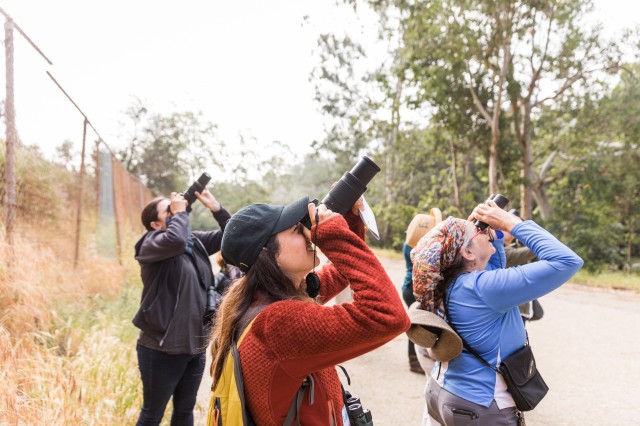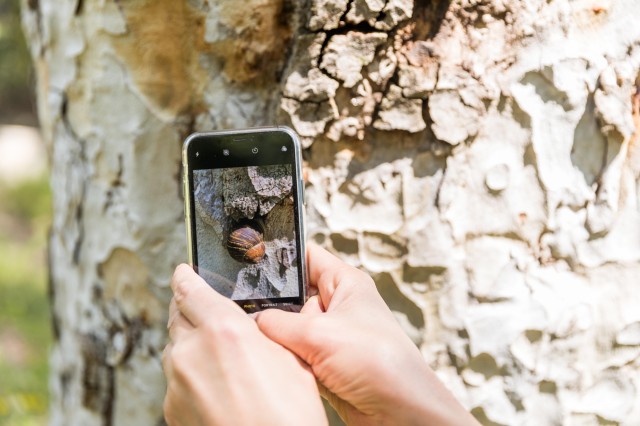Los Angeles, CA (March 31, 2022) – On April 29, the City Nature Challenge—one of the world’s largest community science events—returns for its seventh year of connecting communities with nature and each other! From participating in organized biodiversity surveys to recording the wildlife in your own neighborhood, the City Nature Challenge is the perfect way to explore your local environment—all while contributing to biodiversity science and conservation.
The City Nature Challenge begins on Friday, April 29 at 12:01 am in each time zone and runs through Monday, May 2, 11:59 pm. In light of the COVID-19 pandemic, we urge all participants to carefully follow current public health guidelines. Anyone in a participating City Nature Challenge city can join in by sharing photos of their wildlife observations on the free mobile app iNaturalist, an online platform powered by the California Academy of Sciences and National Geographic, or on their city’s chosen platform. The collective scientific efforts from participants around the world will be tallied and results announced on May 9, 2022.
Launched in 2016 as a collaborative effort between the Natural History Museum of Los Angeles County and California Academy of Sciences, the City Nature Challenge has grown from a friendly competition between the two cities to an international event spanning six continents. The inaugural Challenge recorded an impressive 20,000 observations in the state of California. In 2021, community scientists around the world amassed a record-breaking 1,270,000 observations from over 400 cities across 44 countries. These wildlife observations provide invaluable insights into our planet’s biodiversity, allowing scientists, conservationists, and policymakers to make informed resource management and conservation decisions.
"We’re really excited to see tens of thousands of people come together for this year’s City Nature Challenge," said Lila Higgens, NHM’s Senior Manager of Community Science and co-founder of the Challenge. "This project helps us understand the natural world that lives in our cities, while also connecting people across generations to the plants and animals that surround them everyday. Last year the City Nature Challenge recorded over a million observations. This year I'm hopeful we'll see even more!"
Participation is easy: Any photos of wild plants, animals, or fungi taken during the Challenge can be uploaded to iNaturalist where an online community of naturalists confirms species identifications. Whether you’re participating in an organized “bioblitz” or making observations in your own neighborhood, the Challenge is for budding and seasoned community scientists alike.
-
Find wildlife in your home, neighborhood, backyard, or anywhere else! It can be any wild plant, animal, fungi, slime mold, or any other evidence of life, such as scat, fur, tracks, shells, or carcasses. Check out this guide for tips on finding the surprisingly abundant biodiversity in and around your own home.
-
Take photos and /or sound recordings of what you find using iNaturalist or your city’s chosen platform. You can use your phone and the iNaturalist app, or you can use a camera and upload the photos to the iNaturalist website.
-
Learn more about the plants and animals you find as your observations are identified!
Those not able to take photos or record their observations can focus their efforts on identifying species documented in their area during and after the Challenge. Many organizers in cities around the world will be hosting wildlife identification events from May 3 - May 8.
Over the last six years, observations made during the Challenge have helped scientists detect patterns of biodiversity change on a global and local scale. Some of last year’s highlights include: a threatened giant Australian cuttlefish off the coast of Adelaide, Honduras’s first record of a species of hairstreak butterfly, and an invasive emerald ash borer beetle in Denton County, Texas—its presence suggesting that this species range had expanded.
The City Nature Challenge is a fun, collaborative event that harnesses scientific data to regenerate ecosystems and reverse biodiversity loss. By observing and documenting local wildlife, community scientists give insight into the biodiversity of locations throughout the world.
Participants can also prepare to learn more about the nature surrounding neighborhoods from NHM’s book Wild L.A.: Explore the Amazing Nature In and Around Los Angeles, co-written by our very own Lila Higgins and Greg Pauly. It tells the stories of Los Angeles’ surprising nature, its plants and animals, and how humans interact with all of them. Learn more about this new kind of nature guide at NHM.ORG/wild-la.
Local support for the City Nature Challenge is generously provided by Boeing and the Los Angeles Department of Water and Power.
More Information
Visit citynaturechallenge.org
See participating cities and learn more.
For the latest information on local events, visit NHM.ORG/city-nature-challenge.
iNaturalist
Signing up is easy and free. Visit inaturalist.org from your browser, or download iNaturalist from the Apple App Store or Google Play store.
Social Media
#CityNatureChallenge
Twitter handle: @citnatchallenge
Instagram: @citnatchallenge
About the Natural History Museums of Los Angeles County
The Natural History Museums of Los Angeles County (NHMLAC) include the Natural History Museum in Exposition Park, La Brea Tar Pits in Hancock Park, and the William S. Hart Museum in Newhall. They operate under the collective vision to inspire wonder, discovery, and responsibility for our natural and cultural worlds. The museums hold one of the world’s most extensive and valuable collections of natural and cultural history—more than 35 million objects. Using these collections for groundbreaking scientific and historical research, the museums also incorporate them into on- and offsite nature and culture exploration in L.A. neighborhoods, and a slate of community science programs—creating indoor-outdoor visitor experiences that explore the past, present, and future. Visit NHMLAC.ORG for adventure, education, and entertainment opportunities.
About the California Academy of Sciences
The California Academy of Sciences is a renowned scientific and educational institution with a mission to regenerate the natural world through science, learning, and collaboration. Based in San Francisco’s Golden Gate Park, it is home to a world-class aquarium, planetarium, and natural history museum, as well as innovative programs in scientific research and environmental education—all under one living roof. Museum hours are 9:30 am – 5:00 pm Monday – Saturday, and 11:00 am – 5:00 pm on Sunday. Admission includes all exhibits, programs, and shows. For daily ticket prices, please visit www.calacademy.org or call (415) 379-8000 for more information.
MEDIA CONTACT
For interviews and imagery, please contact Sally Márquez, smarquez@nhm.org.

